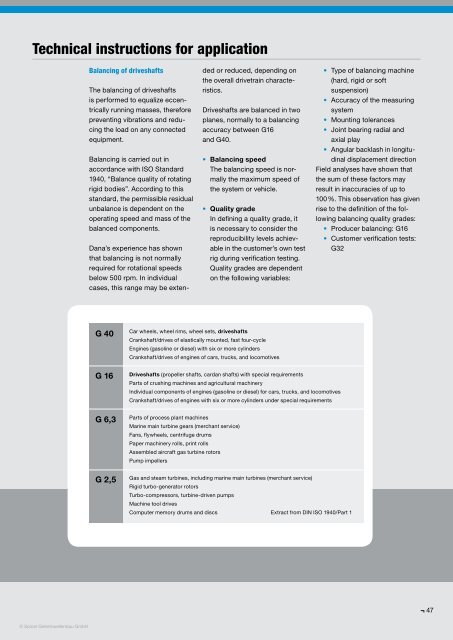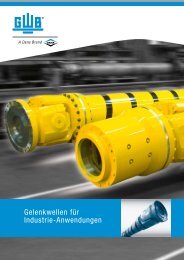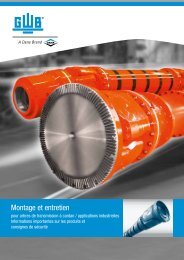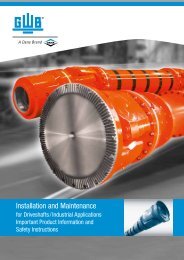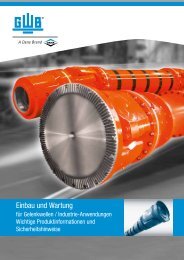Driveshafts for Industrial Applications - GWB
Driveshafts for Industrial Applications - GWB
Driveshafts for Industrial Applications - GWB
Create successful ePaper yourself
Turn your PDF publications into a flip-book with our unique Google optimized e-Paper software.
Technical instructions <strong>for</strong> application<br />
Balancing of driveshafts<br />
The balancing of driveshafts<br />
is per<strong>for</strong>med to equalize eccentrically<br />
running masses, there<strong>for</strong>e<br />
preventing vibrations and reducing<br />
the load on any connected<br />
equipment.<br />
Balancing is carried out in<br />
accordance with ISO Standard<br />
1940, “Balance quality of rotating<br />
rigid bodies”. According to this<br />
standard, the permissible residual<br />
unbalance is dependent on the<br />
operating speed and mass of the<br />
balanced components.<br />
Dana’s experience has shown<br />
that balancing is not normally<br />
required <strong>for</strong> rotational speeds<br />
below 500 rpm. In individual<br />
cases, this range may be extended<br />
or reduced, depending on<br />
the overall drivetrain characteristics.<br />
<strong>Driveshafts</strong> are balanced in two<br />
planes, normally to a balancing<br />
accuracy between G16<br />
and G40.<br />
• Balancing speed<br />
The balancing speed is normally<br />
the maximum speed of<br />
the system or vehicle.<br />
• Quality grade<br />
In defining a quality grade, it<br />
is necessary to consider the<br />
reproducibility levels achievable<br />
in the customer’s own test<br />
rig during verification testing.<br />
Quality grades are dependent<br />
on the following variables:<br />
• Type of balancing machine<br />
(hard, rigid or soft<br />
suspension)<br />
• Accuracy of the measuring<br />
system<br />
• Mounting tolerances<br />
• Joint bearing radial and<br />
axial play<br />
• Angular backlash in longitudinal<br />
displacement direction<br />
Field analyses have shown that<br />
the sum of these factors may<br />
result in inaccuracies of up to<br />
100 %. This observation has given<br />
rise to the definition of the following<br />
balancing quality grades:<br />
• Producer balancing: G16<br />
• Customer verification tests:<br />
G32<br />
G 40<br />
Car wheels, wheel rims, wheel sets, driveshafts<br />
Crankshaft/drives of elastically mounted, fast four-cycle<br />
Engines (gasoline or diesel) with six or more cylinders<br />
Crankshaft/drives of engines of cars, trucks, and locomotives<br />
G 16<br />
<strong>Driveshafts</strong> (propeller shafts, cardan shafts) with special requirements<br />
Parts of crushing machines and agricultural machinery<br />
Individual components of engines (gasoline or diesel) <strong>for</strong> cars, trucks, and locomotives<br />
Crankshaft/drives of engines with six or more cylinders under special requirements<br />
G 6,3<br />
Parts of process plant machines<br />
Marine main turbine gears (merchant service)<br />
Fans, flywheels, centrifuge drums<br />
Paper machinery rolls, print rolls<br />
Assembled aircraft gas turbine rotors<br />
Pump impellers<br />
G 2,5<br />
Gas and steam turbines, including marine main turbines (merchant service)<br />
Rigid turbo-generator rotors<br />
Turbo-compressors, turbine-driven pumps<br />
Machine tool drives<br />
Computer memory drums and discs<br />
Extract from DIN ISO 1940/Part 1<br />
47<br />
© Spicer Gelenkwellenbau GmbH


